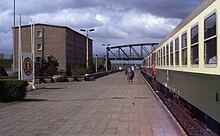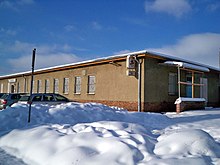Oebisfelde station
| Oebisfelde | |
|---|---|
|
View of the station area from the west
|
|
| Data | |
| Location in the network | Separation station |
| Platform tracks | 4th |
| abbreviation | LOE |
| IBNR | 8010261 |
| Price range | 5 |
| opening | November 1, 1871 |
| Profile on Bahnhof.de | Oebisfelde |
| Architectural data | |
| Architectural style | Founding period |
| location | |
| City / municipality | Oebisfelde-Weferlingen |
| Place / district | Oebisfelde |
| country | Saxony-Anhalt |
| Country | Germany |
| Coordinates | 52 ° 26 '21 " N , 10 ° 59' 2" E |
| Railway lines | |
|
|
|
| Railway stations in Saxony-Anhalt | |
The Oebisfelde train station is a train station in Oebisfelde-Weferlingen in Saxony-Anhalt . In the past up to seven routes went from him. Until 1990 it was the border station between the GDR and the Federal Republic of Germany .
history
Until World War II
The station was built in 1871 on the northern edge of what was then the city of Oebisfelde as part of the construction of the Berlin-Lehrter Railway , which connects Berlin with Hanover . On November 1, 1871, the line was used for the first time for freight traffic, a month later also for passenger traffic. In the following years, Oebisfelde was connected to numerous other places by rail lines. In 1874 the Magdeburg – Neuhaldensleben line was extended to Oebisfelde. In 1889 the route to Salzwedel was inaugurated . Six years later, the Helmstedt – Oebisfelde railway went into operation. At the beginning of the 20th century, Schandelah were connected to the east of Braunschweig (1902) and Wittingen (1909), the latter as a small train with its own station directly north of Oebisfelde station.
Since 1880 Oebisfelde has been the seat of a railway workshop, which was later called the railway depot . The number of trains calling at Oebisfelde station rose continuously. While in 1888 15 passenger trains were counted per day, in 1912 there were already 53 trains. The population of Oebisfeld rose significantly at that time; the railway was the most important employer in the area. In 1910 an overpass was built at the western end of the station due to the heavy train traffic. From 1918 the station was called Oebisfelde-Kaltendorf for a few years, as the two communities had been united into one town.
In 1921 the depot was rebuilt immediately east of the station. In 1934, 199 trains ran daily via Oebisfelde.
In the final years of World War II, the station received several bomb hits. Mainly freight trains were hit.
After the Second World War
When the border was drawn immediately west of Oebisfelde, operations on the route to Wittingen were interrupted in August 1945. The small train station Oebisfelde was renamed Oebisfelde Nord and only served in freight traffic. Traffic in the direction of Helmstedt also came to a standstill, as the route was cut three times by the inner-German border . Until 1952, however, the route was still used by the DR and DB for empty locomotive runs between Helmstedt and Oebisfelde. Finally there were no more trains going to Schandelah . This line was rebuilt in West German territory so that the trains went west to Vorsfelde instead of east to Oebisfelde.
On December 8, 1945, rail traffic to West Germany was resumed. Oebisfelde thus became a border station . On the western side this was Wolfsburg . During the blockade of West Berlin , cross-border traffic in Oebisfelde came to a standstill from June 24 to September 9, 1948. In 1952, a five-kilometer-wide barrier was set up along the inner-German border to prevent GDR citizens from fleeing . The Oebisfelde train station was in this area. In the same year, the southernmost track of the station, track 1, was spatially separated from the other tracks so that passenger traffic with West Germany could be processed there. The north of platform 1, platform 2 had no platform. The border clearance systems were located immediately south of platform 1, west of the reception building . On July 15, 1954, an interzonal train ran for the first time from Hanover to Oebisfelde to Magdeburg. The change of locomotive from locomotives of the Deutsche Reichsbahn to locomotives of the Deutsche Bundesbahn always took place in Oebisfelde. Numerous high-performance steam locomotives were therefore stationed in the depot, and from 1968 diesel locomotives as well .
Interzonal trains ran via Oebisfelde, but no transit trains to West Berlin . These passed through the Helmstedt-Marienborn border crossing to the south . A typical route for interzonal trains via Oebisfelde was Cologne - Leipzig . According to the 1959 summer timetable, two pairs of interzone trains were deployed every day, and three in midsummer.
In 1960, the flyover at the west end of the station was provided with a border fence. In addition to the platform on track 1, there were three platforms with tracks for operations within the GDR as well as track 11 in the north, on which freight trains to and from West Germany could also be handled separately. This track was secured by a protective switch to the west. Only when the person in charge of the border troops gave the order to do so was the switch set to exit towards West Germany. There were also protective points from the west. In addition, it was not technically possible to pass through.
In 1975 four pairs of interzone trains ran via Oebisfelde, five in the summer. In addition, there were nine pairs of trains going to Stendal , ten pairs of trains going to Haldensleben and six to seven pairs of trains to and from Salzwedel .
Steam operation was maintained until 1988. On July 27, 1991, an express train and a tank car train collided immediately to the west of the station . There were three dead; the site had to be cleaned for several years.
Oebisfelde was still served by numerous long-distance trains in the 1991/92 timetable. These included express trains, for example from Cologne to Görlitz and Dresden, as well as trains from Schiphol Airport to Berlin. Only the pair of night trains from Cologne to Moscow passed through the station without stopping. The Cologne – Leipzig interregional line also ran via Oebisfelde until the mid-1990s. The Oebisfelde depot lost its independence on February 16, 1995 and became the location of the Stendal Traktion depot .
In the course of the construction of the high-speed line Hanover – Berlin , the Oebisfelde station was fundamentally redesigned. This meant, among other things, the end of the service of the station in long-distance passenger traffic. By 1998, the number of platforms that could be used for passenger transport had fallen to two island platforms . The platform on track 1 was demolished as were all the platform roofs. To the north and south of the four tracks on the platforms, there have been three more tracks that are mostly used by freight trains. The double-track, electrified high-speed line was laid through the former northern section of the station, the only track connection with the station is around 300 meters west of the station. Since then, only the third, non-electrified track of the Berlin-Lehrter Bahn has led into the station. For the construction of the high-speed line, the exit of the route branching off to the north to Salzwedel had to be relocated at great expense. To this end, around four kilometers of new line were built. This line was closed in 2002. The supervisory staff was withdrawn in 1997. The station restaurant and ticket office were closed around the turn of the millennium.
From December 2006 to December 2018, DB Regio operated passenger transport under the brand name Elbe Saale Bahn .
present
The Oebisfelde station for station category 5. Wolfsburg is the closest long-distance station. Abellio Rail Mitteldeutschland operates passenger transport .
In the 2019 timetable year, Oebisfelde station will be served by the following lines:
| line | Line course | Cycle (min) |
|---|---|---|
| RE 6 | Wolfsburg - Oebisfelde - Haldensleben - Magdeburg | individual trains |
| RB 35 | Wolfsburg - Oebisfelde - Mieste - Gardelegen - Uchtspringe - Stendal |
60 (Mon-Fri) 120 (Sat-Sun) |
| RB 36 | Wolfsburg - Oebisfelde - Wegenstedt - Haldensleben - Barleben - Magdeburg | 120 |
Oebisfelde station is often used to cross with oncoming trains in freight traffic.
Every two hours, buses run from the south side of the station as the “Drömling-Express” to Salzwedel . The line was set up after the cancellation of the trains on the Salzwedel – Oebisfelde railway line. Other buses run in the direction of Weferlingen , Haldensleben and Buchhorst .
The former border clearance building is available and is partly used by a rifle club. A multi-storey house to the west, which was inhabited by members of the border troops, is empty.
Others
- In the local history museum in Oebisfelde Castle , a room is dedicated to the station and the history of the railway in Oebisfelde.
- The axle of a class 41 steam locomotive is on display in front of the station .
- The largest Oebisfeld sports club was called SV Lok Oebisfelde, today SV Oebisfelde.
Picture gallery
literature
- Michael Frick: The Oebisfelde railway junction . Self-published, Oebisfelde 2007.
- Bernd Kuhlmann: Trains through the wall and barbed wire . GVE, Berlin 1998, ISBN 3-89218-050-4 .
Web links
- Information on the Salzwedel – Oebisfelde railway line and Oebisfelde train station
- Steam operation around Oebisfelde
Individual evidence
- ↑ a b c d e Michael Frick: The Oebisfelde railway junction . Self-published, Oebisfelde 2007.
- ↑ a b Information and photos on rail operations in Oebisfelde ( memento of June 8, 2011 in the Internet Archive ), accessed on January 3, 2010.
- ↑ a b DB course book 1959.
- ↑ Bernd Kuhlmann: Trains through the wall and barbed wire . GVE, Berlin 1998, ISBN 3-89218-050-4 .
- ^ DR course book winter 1975.
- ^ DB / DR course book 1991/92.
- ^ Electronic course book of the DB, 2009/10.







